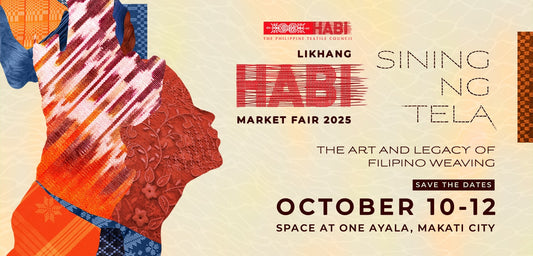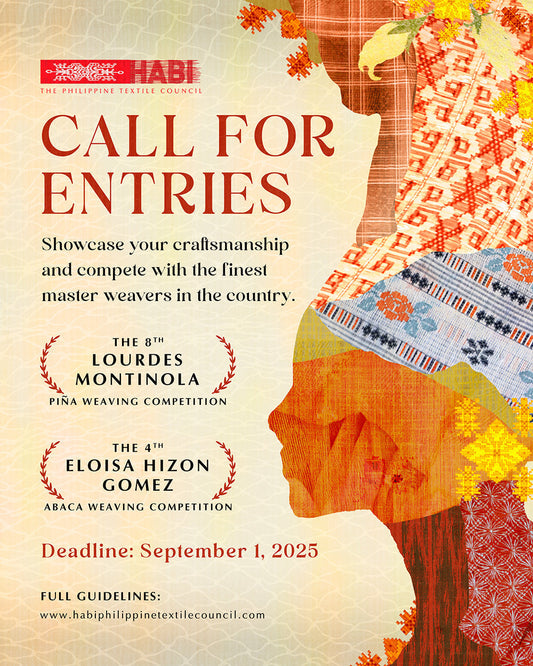In 2015, I was gifted with DVDs that featured our T’boli T’nalak textiles and indigo-dyeing in India. I watched how abaca was naturally dyed in Lake Sebu, South Cotabato, and was fascinated by the magical color that turned Indian cotton and silk textiles the various depths and shades of blue. This led me to look for indigo in the Philippines and, thankfully, the Indigofera tinctoria plant, whose leaves give off blue, grows here! The site of the Philippine Textile Research Institute (PTRI) under the Department of Science and Technology (DOST) also mentioned natural dyes and enumerated which plants gave which color. This is a journey that I’m still on until today.
Among our Philippine dyes, indigo was a major agricultural export of the country in the eighteenth century, along with cotton, rice, wheat, corn, and tobacco. India was also exporting indigo cakes at the same time; but, imagine that, we had indigo as a major agricultural product as early as the days of the Spanish galleon trade! Our widespread use of natural dyes, especially indigo, may have dwindled when synthetic indigo dye and other commercially dyed fabrics arrived in the country in the early 1900s.
So where are our natural dyes today? Who still uses them? Which plants are known dye sources?
According to Beng Camba of the Non-Timber Forest Products (NTFP; at https://ntfp.org/where-we-are/philippines), a consortium of local nongovernment organizations doing “forest conservation, culture protection and promotion, and economic development of forest-dependent communities,” indigo production is one non-forest product that they have been involved in for some time now. They are helping communities in Occidental Mindoro, Rizal, Aklan, Antique, Palawan, and Bukidnon plant and process the Indigofera tinctoria for indigo powder. NFTP chose indigo as their main focus in natural dyes since they believe that “it is the only natural dye that can be produced at the community level.” Other dyes will need more equipment and other added technology in their production. Also, indigenous communities have traditionally used natural dyes, which enhance their handwoven textiles and actually add value.

Talisay Yellow. Photo courtesy of Kat Palasi
A few of our indigenous communities still persist in naturally dyeing their fabrics to this day. The Blaan and T’boli still dye their abaca using local plants grown in their area. Leaves from the knalum (Diospyrus sp.) tree give them black and the roots of the lagu tree (Morinda citrifolia) give them red. Samples of various clothing from the Blaan to the the Bagobo and Kulaman groups in South Central Mindanao are found in Dr. Norma Respicio’s book Our Pattern of Islands. Meanwhile, Ifugao weavers in northern Luzon use plant dyes from Ficus septica, or hawili, for black, and they also dunk their yarns in the mud of the rice terraces! The Itnegs of Abra are also another community that continue to use tayum (Indigofera tinctoria), sapang (Caeselpinia sappan), and other plant dyes in their textiles.
The world of Philippine dyes is a wonderful cornucopia of colors available to us mostly in raw form, except for the processed Indigofera tinctoria powder that is for sale locally. In their raw form, leaves and barks are the usual parts of these dye plants that can be used for color.
Sinaunang Habi, a book by Marian Pastor Roces, mentions a list of dye plants that have been used in our weaving communities before synthetics arrived in the early days. The list includes the following plants: Morinda citrifolia (apatot in Ilocano, noni in Tagalog), Morinda umbellata (halon in Tagalog), Bixa orellana (achote/atchuete in Tagalog), Caeselpinia sappan (sapang in Ilokano or sibukaw in Tagalog), Sesbania gradiflora (katuday in Ilocano, diana in Bagobo), Indigofera tinctoria (dagum in Subanun, tayum-tayuman in Tagalog, tayum in Bisaya), Indigofera suffroticosa mill (bila-bila in Ivatan, piyasak in Maranaw, tina-tinaan in Tagalog, tayum in Panay Bisaya), Indigofera hirsuta (kisul, or lipang-aso, inTagalog; tagom a bombolen in Maranaw; uyun-uyun bantud in Hanunuo Mangyan), Curcuma longa zingiberaceae (luyang dilaw in Tagalog; kalawag in Manobo; kuning, or kuliyaw, in Ilokano; tamangyan in Bikol), Syzygium cumini (duhat in Tagalog, Pinatubo Sambal, and Panay Bisaya).
PTRI’s books on natural dyes (Gampol, Vol. 1, by Laarni P. Habal and Zenaida I. de Guzman and Vol. 2, by Julius Leaño Jr., published in the year 2003 and 2008, respectively) are two slim books that can be a good start for hobbyists, students, or natural-dye enthusiasts. Some of the plants they mention as dye sources are Lantana camara (kantutay in Tagalog), Terminalia catappa (talisay), guava (bayabas in Tagalog), Rhoeo discolor (bangka-bangkaan in Tagalog), Cocos nucifera (niyog), mahogany, Bixa orellana (annato), Pithecellobium dulce (kamachili), Rhizopora mucromata (bakawan), Leucaena glauca (ipil-ipil), and many others.
Where to buy
NTFP indigo powder is available at the Custom Crafts shop of the NTFP at www.cmcrafts.org, or call them at their landline number 89293665. Please look for Julius or Joy.
For Abra indigo powder, the contact person is Nida Agaid (+639977050250) or
Jun Agaid (+639355408089). You may also visit their Facebook page




